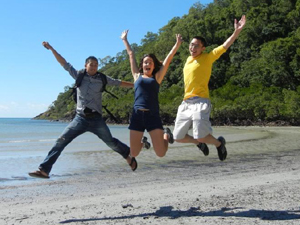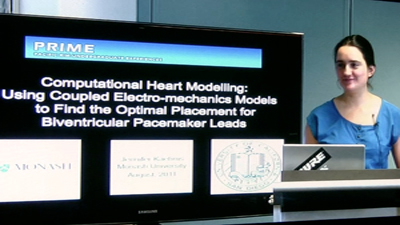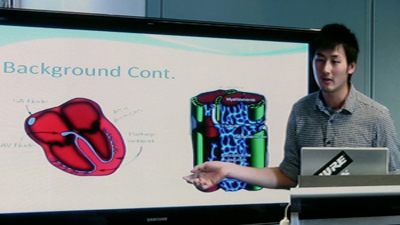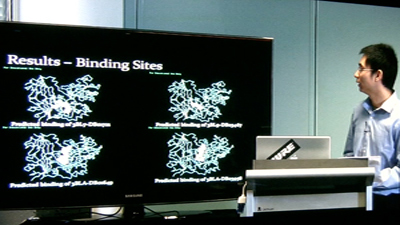PRIME Students Broadcast Streaming Hi-Def Presentations of Summer Research Conducted Abroad
San Diego, Calif., September 21, 2011 -- Under the guidance of University of California, San Diego faculty, three PRIME program students traveled to Melbourne, Australia for the summer to collaborate on computer models of disease processes with faculty at Monash University.
|
The students worked closely with David Abramson, a computer scientist at Monash and director of Monash's eScience and Grid Engineering Lab. Two of the students, working with UCSD mentors in the Cardiac Mechanics Research Group, examined the functional properties of the heart with the goal of understanding cardiac disease. The third student, whose UCSD mentor is from Pharmaceutical Sciences, analyzed treatments for the degeneration of muscles that occurs in spinal muscular atrophy.
“The students always go through a very rapid education about computing when they get to Monash – and then apply their domain expertise to the projects and make a great deal of progress in the nine weeks,” said Abramson.
At the end of the summer, the students had the unique opportunity of giving final presentations about their projects simultaneously to their mentors on both sides of the globe via a live high-definition streaming video feed from Melbourne to a conference room in Atkinson Hall at the UCSD division of the California Institute for Telecommunications and Information Technology (Calit2). The students and audience at Monash were able to see and talk with the UCSD mentors and PRIME program people in real time.
The Pacific Rim Experiences for Undergraduates (PRIME) program provides undergraduates the opportunity to do real research while living for nine weeks in one of several Pacific Rim countries, working with mentors at both the host institution and at UCSD, where the faculty participants come from a variety of departments and research units on campus including Calit2.
The goal of PRIME, now in its eighth year, is to better prepare students to work in the global economy and the research environments of the future. More than 150 students hosted by 14 institutions along the Pacific Rim have participated in the PRIME program, which is funded by the National Science Foundation (NSF), with additional support from Calit2.
“The program provides students with a substantive research experience in using or developing components of the international information technology infrastructure,” says Gabriele Wienhausen, associate dean of education for UCSD’s Division of Biological Sciences and PRIME primary investigator. “It also provides an immersive cultural awareness learning experience.”
“Students in PRIME this year often pursued careers and research projects that were motivated, in part, by personal experiences, with the goal to address issues that affect society.”
Optimal placement of pacemaker leads
|
Kaehms improved upon a computer model of the rabbit heart by incorporating knowledge about the generation and propagation of electrical signals throughout the heart. This new research complemented an existing computer model constructed by previous PRIME students, which explored the mechanics of how the heart beats.
Kaehms then used the resulting electro-mechanical model to simulate the propagation of a pacemaker-generated electrical signal across the surface of the heart. The signal causes the muscles of the heart to contract, as it would normally do to pump blood through the body.
In so doing, Kaehms optimized the model to predict the best location for implanting the leads of a pacemaker to restore proper function to the damaged heart.
“By designing a heart model that is specific to each patient, computational heart modeling proposes to make every patient an individual,” said Kaehms.
“Getting up-to-date on the technical information was the hardest part for me,” said Kaehms, adding that they had plenty of help from technical staff at both Monash and UCSD.
During the course of her project, Kaehms learned an important lesson for her aspiring research career. “If you have hit the proverbial wall, try running something else in parallel while you are figuring out the current problem.”
Modeling local calcium in cardiac muscle cells
|
“Some problems related to heart failure originate from altered fluxes of calcium and sub-cellular geometry (the placement of various organelles and proteins within a cell),” said Tsai, “and since it is difficult to perform experiments directly within individual human heart cells, a computer model becomes essential.”
Tsai explained how the contraction of the heart is initiated by an electrical signal, which propagates across the heart, opening channels through which calcium flows into the muscle cells of the heart. This calcium triggers the release of even more calcium from internal stores within the sarcoplasmic reticulum (SR) network, a convoluted series of ribbon-like membranes within the cell, activating the contractile elements of the heart cell.
Tsai, working with UCSD mentor Johan Hake of the Cardiac Mechanics Research Group and researchers at Monash, modeled the flow of calcium out of the SR, as well as how the SR becomes refilled with calcium following contraction.
“Even though the idea of excitation-contraction coupling seems simple, it is actually a result of many nonlinear interactions between buffers (chemical solutions) and proteins,” explained Tsai. He thinks that understanding calcium movement within heart cells, which is responsible for excitation-contraction coupling, may lead to more effective treatments for heart disease.
Like Kaehms, Tsai also needed time getting up to speed on the technical aspects of his project. “It took me a long time to learn to program in Python”. An additional hurdle was learning the background on the biological aspects of his project. “I didn’t know anything about the heart; I only knew roughly how it works.”
Treatment of spinal muscular atrophy
|
Qiu had two goals for his study of SMA treatments. First, he screened the DrugBank, an online bioinformatics and chemoinformatics database, to find existing drugs and other compounds, which, based on their chemical structure, could bind to the receptors of DcpS. (DcpS is an enzyme thought to play a primary role in SMA and is therefore a target of many drugs). Among Qiu’s top matches for compounds with therapeutic potential were an HIV drug and a flavanoid found in grapefruit.
Qiu then utilized the Protein Data Bank, another online database tool, to identify potential off-target binding sites of the DcpS receptor -- sites on the surface of a cell where a drug could attach to a non-DcpS receptor. When a drug attaches to an unintended receptor, undesirable cellular processes could be triggered which may lead to detrimental side effects. The top matches for SMA drugs from the first part of Qiu’s study can be screened for their likelihood of attaching to off-target binding sites, a process that ultimately reduces the possibility of developing a drug that could produce side effects.
Cultural Exchange
Though the focus of the PRIME program is on collaborative research, exposure to foreign cultures and learning to thrive in a new environment are important element of the student’s nine weeks abroad.
Tsai described a better work-life balance experienced by his Australian collaborators. “Being in Australia is definitely a life-changing experience for me. It made me realize the necessity to find a balance of enjoying life with managing the demands of an exciting career.”
He added, “Instead of finishing my education as soon as possible, I plan to take a year off in each stage of my education and travel around the world and see more things. Traveling around the world is definitely one of the fastest ways to get to know the people and their culture around the world.”
Qiu found himself embracing the non-academic challenges of his PRIME experience. “We may consider being able to take care of ourselves to be independent enough as college students, but being able to eat well, sleep well, and maintain a highly productive researching performance in a foreign country which is a thousand miles away is an entirely different story.”
“Nevertheless, the experience of living in Australia will for sure help me prepare for similar challenges that I may have to face again when I move to another city for graduate school.”
Added Kaehms, “It was my first time abroad so I feel like my scope of the world drastically broadened. I found reading about somewhere new will never compare to living in and experiencing a new place.”
About PRIME
This year’s PRIME host institutions include: Osaka University in Osaka; National Institute for Information and Communications Technology, Kyoto; Doshisha University, Kyoto; the Chinese Academy of Sciences' Computer Network Information Center (CNIC) in Beijing; Monash University in Melbourne; Taiwan’s National Center for Research on Earthquake Engineering (NCREE), Taipei; Taiwan’s National Center for High-Performance Computing (NCHC), Hsinchu; Eco-Informatics Working Group of the Taiwan Forestry Research Institute, Taipei; National Taiwan University, Taipei; the Universiti Sains Malaysia, Penang; as well as the University of Auckland in Auckland.
PRIME 2011 Students at Monash University, Melbourne, Australia
Jennifer Kaehms – Bioengineering major
Computational Heart Modeling: Using Coupled Electro-mechanics Models to Find the Optimal Placement for Biventricular Pacemaker Leads
Mentors: Roy Kerckhoffs (UCSD), David Abramson (Monash University)
Jerry Tsai – Bioengineering and biotechnology major
Computational Modeling of Local Calcium Handling in Cardiac Myocytes
Mentors: Johan Hake (UCSD), David Abramson (Monash University)
Xiaolong Qiu – Chemical engineering major
In Silico Investigation on Potential Off-target Bindings and Repurposable Drugs in the Treatment of Spinal Muscular Atrophy
Mentors: Philip Bourne (UCSD), David Abramson (Monash University)
Related Links
UCSD PRIME
Cardiac Mechanics Research Group
Protein Data Bank
Monash eResearch Centre
Media Contacts
Chris Palmer, crpalmer@mail.ucsd.edu




